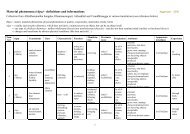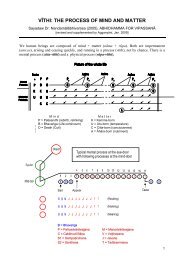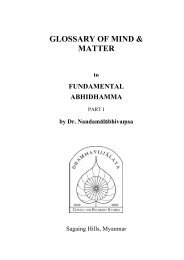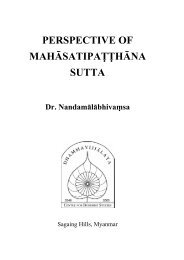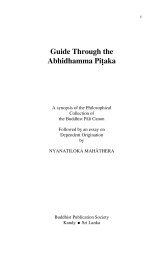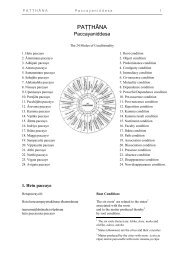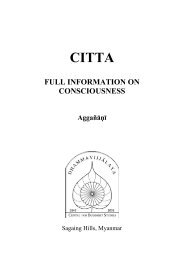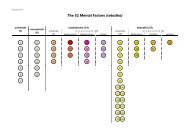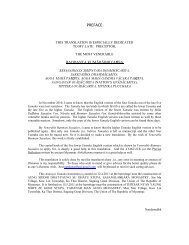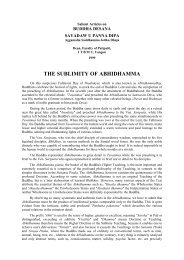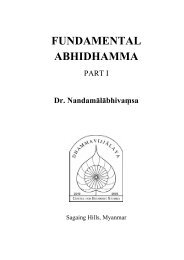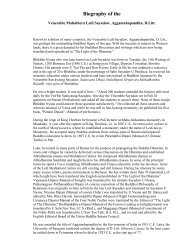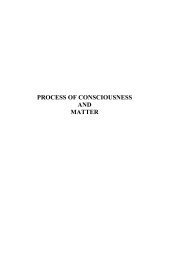ABHIDHAMMA IN DAILY LIFE - Abhidhamma.com
ABHIDHAMMA IN DAILY LIFE - Abhidhamma.com
ABHIDHAMMA IN DAILY LIFE - Abhidhamma.com
Create successful ePaper yourself
Turn your PDF publications into a flip-book with our unique Google optimized e-Paper software.
the matter is the seat of suffering. Then they develop disgust for matter. When they die they<br />
be<strong>com</strong>e Arupa Brahmas, beings without material form in the open space called Arupa Brahma<br />
realm. They live as continuous of consciousness high in the heavens for many kappa’s.<br />
11.12. 3 From Brahma to Hog<br />
Of the Brahmas born in the Brahma realm, the Ariya Brahmas (who have achieved Magga and<br />
Phala) will not go downwards to the lower realms. They soar higher to be<strong>com</strong>e Arahats and<br />
realized Nibbána. However, for Brahmas, who not yet Ariyas, they will have to descend to either<br />
Deva or human abode at the exhaustion of their jhana power. However, they will not fall directly<br />
into the woeful planes. Due to their past wholesome merit they be<strong>com</strong>e Devas or humans in the<br />
next life. From these planes they, according to their own actions, may fall into the four woeful<br />
existences and be<strong>com</strong>e animals, petas or sinners in hell.<br />
In the cycle of samsara, ordinary worldly beings (puthujana) persons, although they reach the<br />
highest abode of Brahmas are liable to fall into bad, lower planes, such as animal kingdom.<br />
There is a saying, "Once a radiant Brahma; next a filthy hog." Being a human (puthujjana) is<br />
very dreadful state. From the highest Brahmas realm, you might one day fall to the woeful<br />
planes. A rocket, missile or a projectile will go skywards as long as there is propulsive energy<br />
once the energy is spent, it must fall down again. So also sentient beings, at the exhaustion of<br />
their jhana power must return to the lower abodes.<br />
11.13 .What is Nibbána<br />
It needs an entire treatise to explain Nibbána in full. In this book I shall give only a few hints,<br />
since there is no room here for exposition of this important subject. Considering that it would be<br />
wiser to leave out this subject entirely than to treat it in a superficial matter. I had not touch upon<br />
it in the earlier editions. However, in order to provide some knowledge of Nibbána to the readers<br />
starting from this 20th edition, I shall give extracts from Thingyo Tika dealing with upasama<br />
nussati, contemplating on the peaceful bliss of Nibbána.<br />
11.14 Meditation on Blissful Tranquility of Nibbana - Upasama Nussati<br />
People usually talk at random about Nibbána. Some wrongly assert that Nibbána is a special case<br />
of mind and matter. Some are mistaken that Nibbána is an eternal essence like a perpetual core,<br />
which remains at the cessation of mind and matter. Another wrong view is that Nibbána<br />
means no bliss because there is no mind or matter to feel any sensation at all. Just as a<br />
sense can only be understood by those who have actually experienced it, the true Nibbána<br />
can only be <strong>com</strong>prehended by Ariya persons who have actually realized the supreme bliss.<br />
The human (puthujjana) persons cannot grasp in full the essence of Nibbána with mere<br />
speculations. Nevertheless, I will try to the best of my ability to explain Nibbána in the light of<br />
texts and in the lights of logical reason.<br />
Nibbána is one of the Supreme Ultimate - it is independent of the other three ultimate truths -<br />
(paramattha sacca), namely<br />
Page 111 A Gift of Dhamma Maung Paw, California



